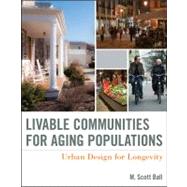
Note: Supplemental materials are not guaranteed with Rental or Used book purchases.
Purchase Benefits
What is included with this book?
| Foreword | p. xi |
| Introduction | p. xiii |
| Preface | p. xiv |
| Acknowledgments | p. xviii |
| Challenges and Opportunities | p. 1 |
| The Longevity Challenge to Urbanism | p. 3 |
| The Challenge | p. 3 |
| The Scale of Response: Pedestrian Sheds and Neighborhoods | p. 7 |
| Seniors Housing Communities as Change Agents | p. 11 |
| Toward the Development of Lifelong Neighborhoods | p. 14 |
| Conclusions | p. 18 |
| Access and Urbanism | p. 21 |
| Introduction | p. 21 |
| Go Forth Boldly | p. 22 |
| On Whose Behalf We Regulate | p. 24 |
| Advancing Accessibility Aspirations Beyond Minimum Standards | p. 31 |
| Stewardship | p. 38 |
| Health, Healthcare, and Urbanism | p. 45 |
| Environmental Health, Safety, and Welfare | p. 45 |
| Reestablishing a Healthy Land-Use Paradigm | p. 48 |
| Knowledge and Action: Finding an Institutional Basis for Public Health and Land-Use Planning Integration | p. 50 |
| Beyond Intent and Toxicity: Establishing Frameworks for Planning Action | p. 54 |
| Beyond Planning: Healthy Environment Implementation Frameworks | p. 64 |
| Neighborhood Wellness and Recreation | p. 71 |
| Urban Design and Wellness Industry Market Research | p. 71 |
| Aging and Wellness | p. 73 |
| Redefining the Lifelong Environment: Wellness in Community | p. 77 |
| Conclusion | p. 86 |
| Networks and Diversity | p. 87 |
| Connections | p. 89 |
| Connectivity | p. 91 |
| Pedestrian Access and Transit | p. 103 |
| Diversity | p. 109 |
| Planning for Diversity | p. 109 |
| Zoning for Diversity | p. 111 |
| Building Codes and Housing Diversity | p. 121 |
| Seniors Housing | p. 125 |
| Evolution of Senior Development Types | p. 129 |
| Early Senior Care Models | p. 129 |
| Institutional Neglect | p. 133 |
| Diversification of the Senior Housing Type | p. 134 |
| The Lifelong Neighborhood Market | p. 149 |
| Market Study Elements of Critical Importance to Lifelong Neighborhoods | p. 149 |
| Factors That Contribute to Residency in Age-Restricted Communities | p. 156 |
| Factors That Deter Older Adults from Moving to Age-Restricted Communities | p. 164 |
| Lifelong Neighborhoods and Influencing Factors | p. 167 |
| Seniors Housing Components | p. 171 |
| Initiating Lifelong Neighborhood Design with a Market Study | p. 172 |
| Seniors Housing Components | p. 174 |
| Service Policy Components | p. 198 |
| Built-Environment Policy Components | p. 199 |
| Urban to Rural Case Studies | p. 207 |
| Penn South Norc Case Study of Aging a Dense Urban Core | p. 209 |
| Lifelong Summary | p. 209 |
| Context | p. 210 |
| Innovations in Health and Wellness Programming: Penn South Discovers the NORC Concept | p. 212 |
| Connectivity and Access | p. 214 |
| Dwellings and Retail | p. 216 |
| Health and Wellness | p. 218 |
| Community Building Spaces | p. 219 |
| Jeff Dullea Intergenerational Garden | p. 220 |
| Beacon Hill Case Study of Aging and Town Centers | p. 223 |
| Lifelong Summary | p. 223 |
| Context | p. 224 |
| Innovations in Health and Wellness Programming | p. 225 |
| Connectivity and Access | p. 226 |
| Dwellings and Retail | p. 227 |
| Health and Wellness | p. 230 |
| Community Building Spaces | p. 232 |
| Mableton Case Study of Aging and Neighborhood Center | p. 235 |
| Lifelong Summary | p. 235 |
| Overview | p. 237 |
| Context | p. 238 |
| Redeveloping as a Lifelong Community | p. 239 |
| Mableton Elementary School Redeveloped as a Civic Center | p. 253 |
| Elder-Centric Villages: Exploring how Senior Housing Can Incentivize Urban Renewal in Rural America | p. 257 |
| Lifelong Summary | p. 257 |
| Evaluating Small-Town Living and Walkability | p. 259 |
| Providing an Elder-Centric Village | p. 263 |
| Index | p. 267 |
| Table of Contents provided by Ingram. All Rights Reserved. |
The New copy of this book will include any supplemental materials advertised. Please check the title of the book to determine if it should include any access cards, study guides, lab manuals, CDs, etc.
The Used, Rental and eBook copies of this book are not guaranteed to include any supplemental materials. Typically, only the book itself is included. This is true even if the title states it includes any access cards, study guides, lab manuals, CDs, etc.